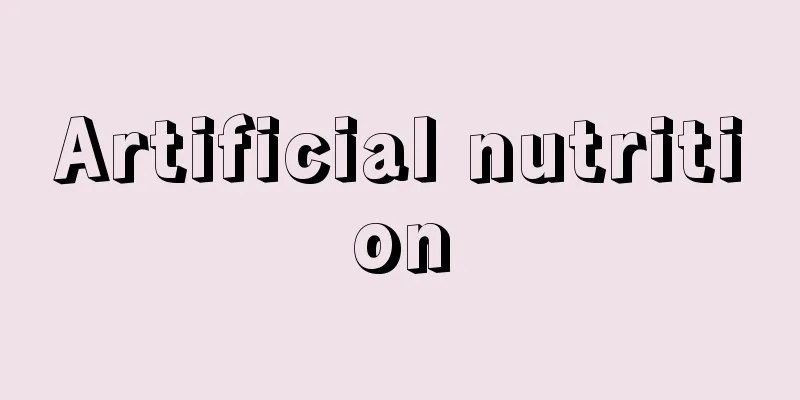Artificial nutrition

|
This refers to feeding an infant without breast milk. In some cases, it may be necessary to feed the infant with formula instead of breast milk due to a lack of breast milk, a mother being unable to breastfeed due to illness, or a mother being unable to breastfeed due to working. There are also cases where breast milk and formula are used together, known as mixed feeding. In the past, most artificial nutrition was based on cow's milk, and many attempts were made to dilute it to 1/3, 1/2, or 2/3 milk depending on the baby's age, or to add sugar. However, the nutritional results of artificial nutrition using cow's milk were not necessarily satisfactory. It was around 1955, when formula milk began to spread, that artificial nutrition became relatively safe, and especially since 1960, special formula milk powder has appeared, making breastfeeding easier and improving nutritional results. Formula milk powder has been improved year by year, and efforts are being made to make it closer to the nutritional efficiency of breast milk. In particular, it is being prepared with the aim of achieving the same nutritional efficiency as breast milk by making proteins into soft curds that are easier to digest and absorb, replacing part of the fat with vegetable oil to increase digestibility and absorbability, or by adding lactose, vitamins, iron supplements, etc. Nowadays, with the improvements in formula milk, formula milk is the most suitable for artificial nutrition during the breastfeeding stage, and cow's milk should not be used as a general rule. After weaning, formula milk should be used while the baby is still eating small amounts of weaning food, and it is advisable to switch to cow's milk from around 9 months of age, when the baby begins to eat three meals a day. With regard to artificial feeding, the amount of milk fed becomes an issue, and there is debate as to whether autonomous feeding should be used. Currently, the autonomous feeding method, in which an infant is fed as much as they want when they want, is widely used, but there are two points to keep in mind when doing so. First, with artificial feeding, it is preferable to keep the intervals and number of feedings constant according to the infant's development, and to feed the infant as much as they want each time. Second, until the infant is two months old, when the infant's autonomous feeding ability matures, it is dangerous to rely on autonomous feeding, and the amount of milk should be limited to no more than 200 milliliters at one time and 1,000 milliliters per day. In other words, from some time after birth until around two months old, the infant is in the stage of sucking reflexively, and because the sucking force is strong and the ability to regulate is insufficient, there is a tendency for the infant to drink too much. Artificial feeding is used when breastfeeding is difficult, and since it is a practically necessary method of nutrition, it is important not to overemphasize the superiority of breastfeeding and make mothers feel unnecessary guilty for not breastfeeding. Since the development of special infant formula, artificial feeding has improved year by year, but we must not forget that the most important thing is to breastfeed in a way that is comfortable for both the mother and the baby. [Hoashi Eiichi] [Reference] | | |Source: Shogakukan Encyclopedia Nipponica About Encyclopedia Nipponica Information | Legend |
|
母乳を用いずに乳児を哺育(ほいく)することをいう。母乳不足であったり、母親が疾病のため授乳できない、あるいは母親が就労中のため母乳が与えられないなどの理由によって、母乳以外の人工乳によって哺育が必要とされることがある。また混合栄養といって、母乳と人工乳を併用する場合もある。 人工栄養は、かつてはほとんどが牛乳をベースとし、乳児の月齢に応じて1/3乳、1/2乳、2/3乳と種々に薄めたり、砂糖を加えたり、検討とくふうが重ねられてきた。しかし、牛乳を用いた人工栄養方式に基づく栄養成績はかならずしも十分とはいえなかった。人工栄養法が比較的安全になってきたのは、調製乳が普及し始めた1955年(昭和30)前後からであり、とくに60年以降、特殊調製粉乳が出現して、授乳法も簡単となり、栄養成績も向上してきている。調製粉乳は年々改良され、母乳の栄養効率に近づけるように努力されている。とくにタンパクを消化・吸収しやすいソフトカード化、脂肪の一部を植物油に置き換えることによって、その消化・吸収性を高め、あるいは乳糖やビタミン、鉄剤などの添加によって、母乳と同様の栄養効率を図る方向で調製されている。 このように調製粉乳が改善された今日においては、乳汁期の人工栄養には調製粉乳がもっとも適しており、原則として牛乳を用いるべきではない。また離乳期以後については、離乳食が少ない間は調製粉乳を用いるべきで、3回食となる9か月ごろから牛乳に切り替えることが望ましい。 人工栄養に関しては、授乳量が問題となり、自律授乳とすべきかどうかが論じられている。現在では自律授乳方式といって、乳児の欲するときに、欲しがるだけ与える方法が普及しているが、この際に留意すべき点が二つある。第一は、人工栄養では、発達に応じた授乳の間隔や回数は一定にしておき、毎回の哺乳量を欲しがるだけ与えるという方法が好ましい。第二は、自律哺乳能力が成熟する生後2か月までは、自律授乳に依存することは危険で、1回量200ミリリットル、1日量1000ミリリットルを超さないように制限する必要がある。つまり、生後しばらくしてから2か月ごろまでは、反射的に吸う段階にあり、吸う力のみが強く、調整力が不十分なため、飲みすぎる傾向がある。 人工栄養は、母乳栄養が困難な場合に行われるわけで、現実的に必要な栄養法であるから、母乳栄養の優れていることを強調しすぎるあまり、母乳栄養でないことに対する無用な罪悪感を母親に抱かせないことがたいせつである。特殊調製粉乳が開発されて以来、年々人工栄養も向上している現在、なによりもたいせつなことは、母親にとっても乳児にとっても、快適な授乳を行うことにあることを忘れてはならない。 [帆足英一] [参照項目] | | |出典 小学館 日本大百科全書(ニッポニカ)日本大百科全書(ニッポニカ)について 情報 | 凡例 |
Recommend
"Kanto Heiranki" - Kanto Heiranki
…A record of the medieval Kanto wars. Also called...
Italian Roast - Italian Roast
…Espresso is made in a way that is widely used in...
Viennese temperament
A waltz for orchestra (1871) by Austrian composer ...
Treaty of Aihun
A treaty signed at Aihun on May 28, 1858 (the 8th ...
Fried - Fried
...The molten metal flows from the pouring pool t...
Cutting edge
〘Noun〙① = kiriha (cutting edge)② A cut in a Joruri...
Milyutin, Dmitrii Alekseevich
Born: July 10, 1816, Moscow [Died] February 7, 191...
Enrei - Enrei
…A pass in the central part of Nagano Prefecture....
Lamprothamnium succinctum (English spelling)
... There are six species of freshwater algae tha...
Character - Nickname
〘Name〙①(i) In China, an alias given to a boy at th...
Cotton red fang moth - Pectinophora gossypiella
An insect of the Lepidoptera family Gelechiidae. W...
Hydrotalcite
...In addition, there are related minerals that c...
Akadama - Akadama
This refers to reddish-brown jasper that is used ...
Kim In-mun (English spelling)
629‐694 A royal general of Silla, Korea. His pen n...
Yoshikuni Katsu
...A politician in the late Edo and Meiji periods...




![Cagayan [River] - Cagayan](/upload/images/67cb2d5ed0456.webp)




